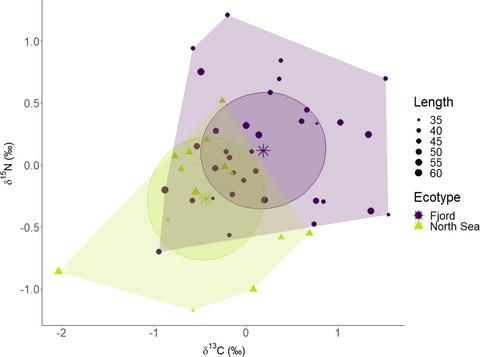当前位置:
X-MOL 学术
›
Ecol. Evol.
›
论文详情
Our official English website, www.x-mol.net, welcomes your feedback! (Note: you will need to create a separate account there.)
Disparate movement behavior and feeding ecology in sympatric ecotypes of Atlantic cod
Ecology and Evolution ( IF 2.6 ) Pub Date : 2021-07-26 , DOI: 10.1002/ece3.7939 Martin Lykke Kristensen 1 , Esben Moland Olsen 2, 3 , Even Moland 2, 3 , Halvor Knutsen 2, 3 , Peter Grønkjær 4 , Anders Koed 1 , Kristi Källo 1 , Kim Aarestrup 1
Ecology and Evolution ( IF 2.6 ) Pub Date : 2021-07-26 , DOI: 10.1002/ece3.7939 Martin Lykke Kristensen 1 , Esben Moland Olsen 2, 3 , Even Moland 2, 3 , Halvor Knutsen 2, 3 , Peter Grønkjær 4 , Anders Koed 1 , Kristi Källo 1 , Kim Aarestrup 1
Affiliation

|
Coexistence of ecotypes, genetically divergent population units, is a widespread phenomenon, potentially affecting ecosystem functioning and local food web stability. In coastal Skagerrak, Atlantic cod (Gadus morhua) occur as two such coexisting ecotypes. We applied a combination of acoustic telemetry, genotyping, and stable isotope analysis to 72 individuals to investigate movement ecology and food niche of putative local “Fjord” and putative oceanic “North Sea” ecotypes—thus named based on previous molecular studies. Genotyping and individual origin assignment suggested 41 individuals were Fjord and 31 were North Sea ecotypes. Both ecotypes were found throughout the fjord. Seven percent of Fjord ecotype individuals left the study system during the study while 42% of North Sea individuals left, potentially homing to natal spawning grounds. Home range sizes were similar for the two ecotypes but highly variable among individuals. Fjord ecotype cod had significantly higher δ13C and δ15N stable isotope values than North Sea ecotype cod, suggesting they exploited different food niches. The results suggest coexisting ecotypes may possess innate differences in feeding and movement ecologies and may thus fill different functional roles in marine ecosystems. This highlights the importance of conserving interconnected populations to ensure stable ecosystem functioning and food web structures.
中文翻译:

大西洋鳕同域生态型的不同运动行为和摄食生态
生态型共存、遗传上不同的人口单位是一种普遍现象,可能影响生态系统功能和当地食物网的稳定性。在沿海斯卡格拉克,大西洋鳕鱼 ( Gadus morhua) 作为两个这样的共存生态型发生。我们对 72 个人应用了声学遥测、基因分型和稳定同位素分析的组合,以研究假定的本地“峡湾”和假定的海洋“北海”生态型的运动生态学和食物生态位 - 因此根据之前的分子研究命名。基因分型和个体起源分配表明 41 个体是峡湾生态型,31 个体是北海生态型。整个峡湾都发现了两种生态型。在研究期间,7% 的峡湾生态型个体离开了研究系统,而 42% 的北海个体离开了,可能会返回出生产卵地。两种生态型的家庭范围大小相似,但个体之间差异很大。峡湾生态型鳕鱼的 δ 13 C 和 δ 15显着较高N 稳定同位素值高于北海生态型鳕鱼,表明它们利用了不同的食物生态位。结果表明,共存的生态型可能在摄食和运动生态方面具有先天差异,因此可能在海洋生态系统中发挥不同的功能作用。这凸显了保护相互关联的种群以确保稳定的生态系统功能和食物网结构的重要性。
更新日期:2021-08-16
中文翻译:

大西洋鳕同域生态型的不同运动行为和摄食生态
生态型共存、遗传上不同的人口单位是一种普遍现象,可能影响生态系统功能和当地食物网的稳定性。在沿海斯卡格拉克,大西洋鳕鱼 ( Gadus morhua) 作为两个这样的共存生态型发生。我们对 72 个人应用了声学遥测、基因分型和稳定同位素分析的组合,以研究假定的本地“峡湾”和假定的海洋“北海”生态型的运动生态学和食物生态位 - 因此根据之前的分子研究命名。基因分型和个体起源分配表明 41 个体是峡湾生态型,31 个体是北海生态型。整个峡湾都发现了两种生态型。在研究期间,7% 的峡湾生态型个体离开了研究系统,而 42% 的北海个体离开了,可能会返回出生产卵地。两种生态型的家庭范围大小相似,但个体之间差异很大。峡湾生态型鳕鱼的 δ 13 C 和 δ 15显着较高N 稳定同位素值高于北海生态型鳕鱼,表明它们利用了不同的食物生态位。结果表明,共存的生态型可能在摄食和运动生态方面具有先天差异,因此可能在海洋生态系统中发挥不同的功能作用。这凸显了保护相互关联的种群以确保稳定的生态系统功能和食物网结构的重要性。


























 京公网安备 11010802027423号
京公网安备 11010802027423号